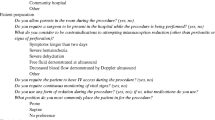Abstract
The hydrostatic pressures and flow rates of barium sulphate and water soluble contrast in concentrations representative of those used for intussusception reduction were measured. The change of height with discharge of fluid from the filled kit was also assessed. A group of experienced paediatric radiologists and radiographers significantly underestimated the height to which contrast should be placed for intussusception reduction. The results indicate that baseline hydrostatic reduction pressures tend to be less and maximum pressures significantly less than those presently advocated for pneumatic reduction. This disparity may account for the apparent improvement in intussusception reduction rates reported for air enema when compared with barium enema. Intraluminal pressure monitoring during contrast enema would aid control of intussusception reduction but hydrostatic reduction would still be at a disadvantage because of lower flow rates. Where hydrostatic reduction is performed, the contrast density and height used should be set to give known pressure, according to local guidelines.
Similar content being viewed by others
References
Gu L, Alton DJ, Daneman A, Stringer DA, Liu P, Wilmot DM, Reilly BJ (1988) Intussusception reduction in children by rectal insufflation of air. AJR 150: 1345
Phelan E, de Campo JF, Malecky G (1988) Comparison of oxygen and barium reduction of ileocolic intussusception. AJR 150: 1349
Ravitch MM, in Ravitch MM, Welch KJ, Benson CD, Aberdeen E, Randolph JG (1979) Pediatric Surgery, 2nd edn. Year Book Medical Publishers, Chicago, p 1349
Bisset GS, Kirks DR (1988) Intussusception in infants and children: diagnosis and therapy. Radiology 168: 141
Bruce J, Huh YS, Cooney DR, Karp MP, Allen JE, Jewett TC (1987) Intussusception: evolution of current management. J Pediatr Gastroenterol Nutr 6: 6635
Touloukian RJ, O'Connell JB, Markowitz RI, Rosenfield N, Seashore JH, Ablow RC (1987) Analgesic premedication in the management of ileocolic intussusception. Pediatrics 79: 432
Gierup J, Joulf H, Livaditis A (1972) Management of intussusception in infants and children: a survey based on 288 consecutive cases. Pediatrics 50: 535
Diner W, Patel G, Texter EC, Baker ML, Tune JM, Hightower MD (1981) Intraluminal pressure measurements during barium enema: full column vs air contrast. AJR 131: 217
Kozarek RA, Earnest DL, Silverstein ME, Smith RG (1980) Airpressure induced colon injury during diagnostic colonoscopy. Gastroenterology 78: 79
Humphry A, Ein SH, Mok PM (1981) Perforation of the intussuscepted colon. AJR 137: 1135
Sjogren RW, Heit HA, Johnson LF, Gremillion DE, Butler ML, Cammerer RC (1978) Serosal laceration: a complication of indients. Gastroentest Endosc 24: 2399
Author information
Authors and Affiliations
Rights and permissions
About this article
Cite this article
Sargent, M.A., Wilson, B.P.M. Are hydrostatic and pneumatic methods of intussusception reduction comparable?. Pediatr Radiol 21, 346–349 (1991). https://doi.org/10.1007/BF02011483
Received:
Accepted:
Issue Date:
DOI: https://doi.org/10.1007/BF02011483




